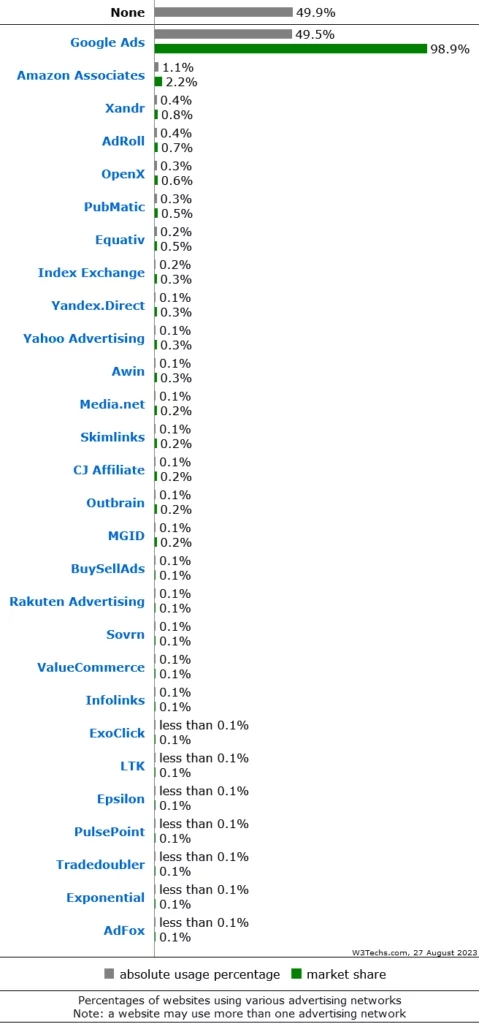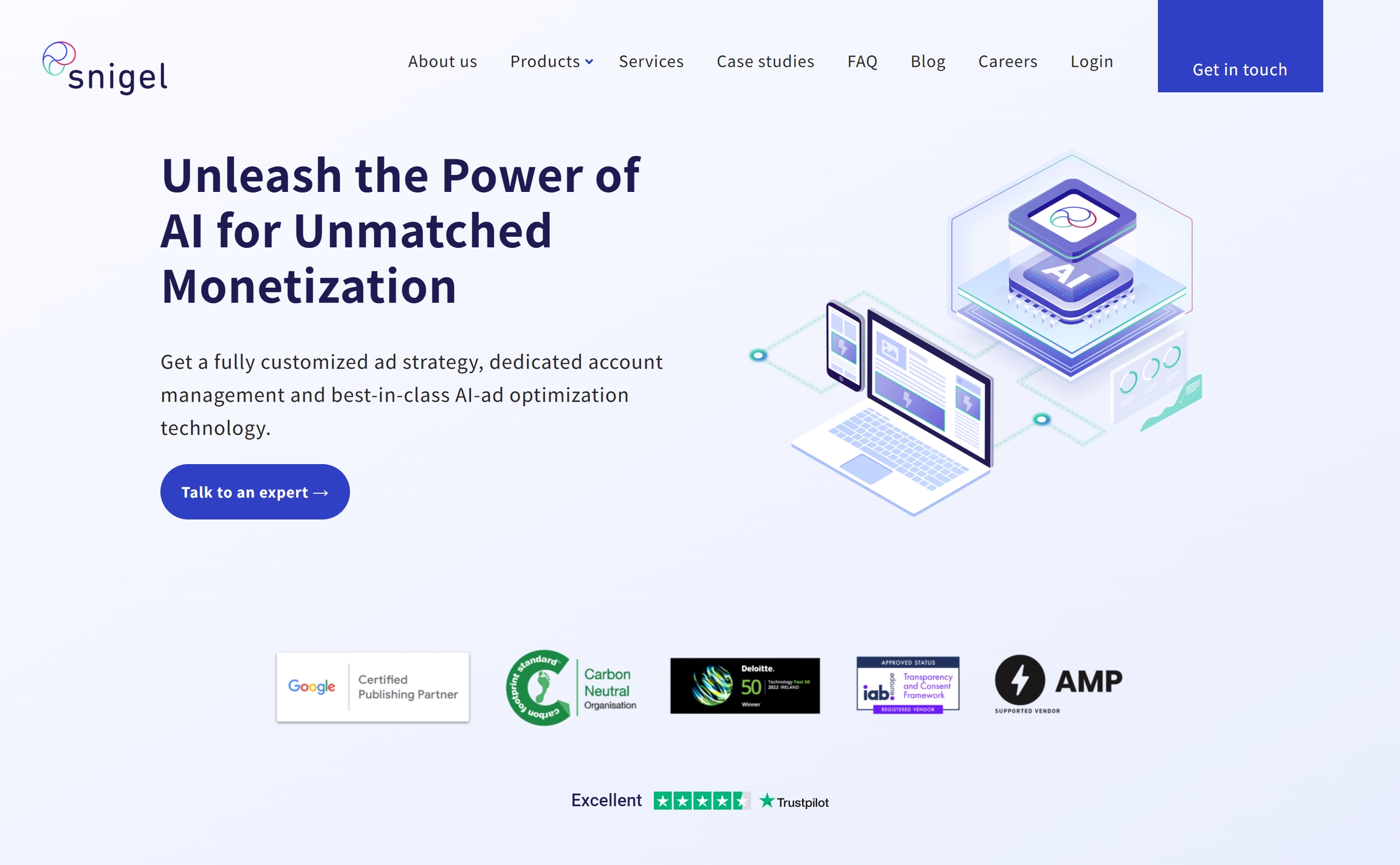Revolutionizing Digital Advertising and Maximizing Revenue with Ad Network Platforms
Buy CPC Traffic | Buy Display Ads | Exclusive traffic sources | Buy Push Ads | Popunder ADS | Buy Native Ads | Buy Preroll Ads

Buy CPC Traffic | Buy Display Ads | Exclusive traffic sources | Buy Push Ads | Popunder ADS | Buy Native Ads | Buy Preroll Ads
In today's digital age, advertising has become an integral part of the online ecosystem. With millions of websites and apps vying for users' attention, the competition to capture and retain audiences has never been fiercer. This is where ad network platforms come in, offering a solution for advertisers and publishers to effectively reach their target audience while maximizing revenue potential.
An ad network platform acts as a mediator between advertisers, publishers, and users. It consolidates ad inventory from various publishers and matches them with relevant advertisements based on user preferences and browsing behavior. By strategically placing ads across a network of websites and apps, these platforms enable advertisers to reach a wider audience and increase brand visibility.
One of the key advantages of ad network platforms is their ability to maximize revenue potential for publishers. By leveraging advanced targeting and optimization algorithms, these platforms can identify the highest paying ads and deliver them to the most relevant websites and apps. This not only ensures that publishers earn higher revenues from their ad space but also enhances user experience by displaying ads that are more likely to resonate with their interests.
Furthermore, ad network platforms offer a range of ad formats and targeting options to cater to advertisers' specific marketing objectives. From traditional banner ads to immersive video ads, these platforms provide advertisers with the flexibility to create engaging and interactive ad experiences. They also offer targeting options such as demographic targeting, behavioral targeting, and contextual targeting, allowing advertisers to reach their desired audience with precision.
In conclusion, ad network platforms have revolutionized digital advertising by connecting advertisers and publishers in a seamless ecosystem. They have not only transformed the way ads are delivered and monetized but also created new opportunities for businesses to reach and engage their target audience. With their advanced targeting capabilities and revenue optimization techniques, these platforms are set to reshape the future of digital advertising and drive higher returns for all stakeholders involved.
What are Ad Network Platforms?

Ad Network Platforms are digital platforms that connect advertisers with publishers, allowing them to collaborate and maximize their revenue potential. These platforms serve as intermediaries between advertisers who want to promote their products or services and publishers who want to monetize their websites or apps by displaying ads.
Ad Network Platforms provide a variety of ad formats, such as display ads, video ads, native ads, and popunder ads. They have access to a vast network of publishers across different websites and apps, offering advertisers the opportunity to reach a wider audience and publishers the chance to monetize their traffic.
These platforms typically work on a cost-per-click (CPC) or cost-per-impression (CPM) basis, allowing advertisers to pay only when their ads are clicked on or seen by users. They use advanced targeting technologies to ensure that the right ads are shown to the right audience, increasing the chances of user engagement and conversion.
Ad Network Platforms also provide advertisers and publishers with detailed analytics and reporting, allowing them to track the performance of their ad campaigns and optimize their strategies for better results. They offer various targeting options, such as demographic targeting, behavioral targeting, and contextual targeting, to help advertisers reach their desired audience effectively.
In conclusion, Ad Network Platforms revolutionize digital advertising by providing a seamless connection between advertisers and publishers, enabling them to maximize their revenue potential. With a wide range of ad formats and advanced targeting options, these platforms offer a powerful solution for reaching the right audience and achieving marketing goals.
Importance of Ad Network Platforms

Ad network platforms have become an integral part of the digital advertising ecosystem. These platforms offer a variety of benefits to both advertisers and publishers, making them essential for maximizing revenue potential.
One of the key advantages of ad network platforms is their ability to connect advertisers and publishers in a streamlined and efficient manner. These platforms provide a centralized marketplace where advertisers can easily find and purchase ad space from publishers. On the other hand, publishers can monetize their website or app by easily integrating ad network platforms and displaying ads from various advertisers.
Another important benefit of ad network platforms is their targeting capabilities. These platforms utilize advanced targeting technologies to deliver ads to specific audiences based on their demographics, interests, and online behavior. This level of targeting ensures that ads are shown to the most relevant audiences, increasing the chances of engagement and conversions.
In addition, ad network platforms offer various ad formats to cater to the diverse needs and preferences of advertisers and publishers. Whether it's display ads, native ads, video ads, or popunder ads, these platforms provide a wide range of options to choose from. This versatility allows advertisers to create engaging ad campaigns and publishers to optimize their ad revenue.
Furthermore, ad network platforms offer comprehensive analytics and reporting features. These tools provide valuable insights into the performance of ad campaigns, allowing advertisers and publishers to make data-driven decisions and optimize their strategies. With access to real-time data, they can monitor ad impressions, clicks, conversions, and other metrics to measure the success of their campaigns.
In conclusion, ad network platforms play a crucial role in revolutionizing digital advertising by connecting advertisers and publishers, offering advanced targeting capabilities, providing various ad formats, and offering comprehensive analytics. By leveraging these platforms, businesses can maximize their revenue potential and achieve their advertising goals.
Revolutionizing Digital Advertising

The advent of ad network platforms has brought about a significant revolution in the world of digital advertising. These platforms have reshaped the way advertisers and publishers interact, maximizing revenue potential and expanding the reach of digital marketing campaigns.
One of the key ways ad network platforms have revolutionized digital advertising is through their ability to target specific audiences with precision. By leveraging advanced targeting technologies, these platforms enable advertisers to deliver their messages to the right people at the right time. This not only ensures that ads are more effective but also helps to minimize ad fatigue for users.
Furthermore, ad network platforms have significantly simplified the process of ad campaign management. With these platforms, advertisers can easily create, monitor, and optimize their campaigns in real-time. This level of control and flexibility allows advertisers to make data-driven decisions and continuously improve the performance of their ads.
In addition to targeting and campaign management, ad network platforms have also played a crucial role in expanding the reach of digital advertising. By connecting advertisers with a vast network of publishers, these platforms enable ads to be displayed on a wide range of websites and apps. This not only increases the visibility of ads but also helps to reach a more diverse audience, further enhancing the effectiveness of digital marketing efforts.
The revolution brought about by ad network platforms has not only benefited advertisers but has also been advantageous for publishers. These platforms provide publishers with an easy and efficient way to monetize their online content. Publishers can join ad networks, integrate ad placements into their websites or apps, and earn revenue based on user interactions with the displayed ads.
In conclusion, ad network platforms have revolutionized digital advertising by offering precise audience targeting, simplified campaign management, expanded reach, and increased revenue potential for both advertisers and publishers. As technology continues to advance, these platforms will likely continue to evolve and shape the future of digital advertising.
Targeted Advertising

Targeted advertising is a key feature of ad network platforms and has revolutionized the world of digital advertising. It involves displaying ads to a specific audience that is more likely to be interested in the product or service being advertised.
Ad network platforms collect a vast amount of data on users, such as their demographics, interests, online behavior, and more. This data is used to create user profiles and target ads based on these profiles. By analyzing this data, advertisers can tailor their ad campaigns to reach the desired audience and maximize the chances of conversion.
Targeted advertising offers many benefits to both advertisers and publishers. For advertisers, it means more efficient use of their advertising budget, as they can reach the right audience with the right message. This leads to higher click-through rates, engagement, and conversions.
For publishers, targeted advertising increases the value of their ad inventory. Advertisers are willing to pay a premium to reach a specific audience, and publishers can generate more revenue from their ads. Targeted ads are also less disruptive to users, as they are more relevant and align with their interests.
Ad network platforms enable targeted advertising by offering advanced targeting options, such as demographic targeting, behavioral targeting, geographic targeting, and retargeting. These options allow advertisers to refine their target audience based on specific criteria and ensure their ads are shown to the right people at the right time.
In conclusion, targeted advertising has revolutionized digital advertising by allowing advertisers to reach the right audience with more relevant and personalized ads. Ad network platforms play a crucial role in enabling targeted advertising and maximizing the revenue potential for both advertisers and publishers.
Real-time Bidding
Real-time bidding (RTB) is a key component of ad network platforms that revolutionizes the digital advertising landscape by enabling advertisers to bid on ad impressions in real-time. With RTB, advertisers can access a vast network of publishers and bid for their ad placements as soon as they become available.
The process of real-time bidding happens within milliseconds, allowing advertisers to target specific audiences and optimize their ad campaigns in real-time. This data-driven approach improves advertising efficiency and increases the likelihood of reaching the right audience at the right time.
RTB provides numerous benefits for both advertisers and publishers. Advertisers can leverage RTB to target their ads to specific demographics, locations, and interests, maximizing the impact of their campaigns. The ability to bid in real-time also means that advertisers can set their own maximum price for each ad impression, ensuring that they achieve the best possible return on investment.
For publishers, real-time bidding opens up new revenue streams and allows them to monetize their ad inventory more effectively. By connecting with multiple ad exchanges and demand-side platforms, publishers can sell their ad impressions to the highest bidder, ensuring they receive the maximum possible revenue for each impression.
How Real-time Bidding Works
Real-time bidding involves a complex process that occurs in the blink of an eye. Here are the key steps:
Ad impression availability: When a user visits a website or uses an app, a request for an ad impression is sent to the ad exchange.
Auction initiation: The ad exchange holds an auction for the available impression, notifying potential advertisers.
Advertiser bidding: Advertisers receive information about the impression and can choose whether to bid or not. They can analyze the user's data and determine the maximum amount they are willing to pay.
Bid submission: Advertisers submit their bids electronically back to the ad exchange within the time frame set for the auction.
Bid evaluation: The ad exchange evaluates the bids and determines the winning bid based on predefined criteria, such as highest bid or highest bid combined with other factors.
Ad serving: Once the winning bidder is determined, the ad exchange informs the publisher, and the winning ad is served to the user in real-time.
The Advantages of Real-time Bidding

Real-time bidding offers several advantages over traditional digital advertising methods:
Increased efficiency: Real-time bidding allows advertisers to reach their target audience with precision, minimizing ad wastage and maximizing campaign performance.
Enhanced revenue potential: For publishers, real-time bidding ensures they receive the highest possible revenue for each ad impression.
Improved targeting capabilities: Advertisers can leverage data and advanced targeting options to reach specific demographics and interests.
Flexible budget control: Advertisers can set their own maximum bid for each impression, enabling them to optimize their budget and achieve better ROI.
Real-time optimization: Advertisers can continuously monitor and adjust their ad campaigns in real-time, optimizing for performance and engagement.
In conclusion, real-time bidding is a powerful tool that has revolutionized the digital advertising industry. By enabling advertisers to bid on ad impressions in real-time and providing publishers with new revenue opportunities, RTB has transformed the way digital advertising works, delivering increased efficiency, revenue potential, and targeting capabilities.
Maximizing Revenue Potential
In today's highly competitive digital advertising landscape, maximizing revenue potential is crucial for success. Ad network platforms play a vital role in helping publishers and advertisers optimize their revenue streams.
One of the key ways ad network platforms maximize revenue potential is through targeted advertising. By leveraging advanced data analytics and user behavior tracking, these platforms can deliver ads to highly relevant audiences, increasing the likelihood of engagement and conversion. This targeted approach not only improves the effectiveness of advertising campaigns but also maximizes revenue by driving higher click-through rates and conversion rates.
Additionally, ad network platforms provide detailed insights and analytics to publishers and advertisers, enabling them to make data-driven decisions to optimize their revenue potential. These insights include data on ad performance, audience demographics, and engagement metrics, allowing businesses to identify successful strategies and make informed adjustments.
Furthermore, ad network platforms often offer features like real-time bidding and dynamic ad insertion, which enable publishers to maximize revenue potential through programmatic advertising. Real-time bidding allows publishers to sell their ad inventory to the highest bidder, ensuring optimized revenue for each impression. Dynamic ad insertion, on the other hand, allows for personalized and relevant ad placement, increasing the chances of user engagement and revenue generation.
Another important aspect of maximizing revenue potential with ad network platforms is the ability to scale advertising campaigns. These platforms typically have access to a vast network of publishers and advertisers, allowing businesses to reach a broader audience and maximize their revenue potential. Whether it's through display ads, video ads, or native ads, ad network platforms provide a variety of ad formats and placements to cater to different advertising needs and maximize revenue generation.
In conclusion, ad network platforms revolutionize digital advertising by maximizing revenue potential for publishers and advertisers. Through targeted advertising, detailed analytics, programmatic capabilities, and scalability, these platforms help businesses optimize their revenue streams and achieve success in the competitive digital landscape.
Monetization Strategies

Maximizing revenue potential is a top priority for ad network platforms. To achieve this, they implement various monetization strategies, including:
Display Ads: Ad network platforms generate revenue by displaying targeted ads on publisher websites. These ads can be in the form of banners, pop-ups, or interstitials. Advertisers pay the ad network platforms for impressions or clicks.
Native Ads: Native advertising is becoming increasingly popular as it seamlessly integrates ads into the content, providing a better user experience. Ad network platforms place sponsored content within the publisher's website or app, making it appear native to the platform.
Video Ads: With the rise of video streaming platforms, video ads have become a lucrative monetization strategy. Ad network platforms work with publishers to deliver video ads before, during, or after video content. These ads generate revenue through completed views or clicks.
Mobile Ads: As mobile usage continues to grow, ad network platforms have adapted their strategies to include mobile ads. These ads are optimized for mobile screens and can be displayed within mobile apps or mobile websites.
Subscription Services: Some ad network platforms offer publishers the option to implement subscription-based models, where users pay a recurring fee to access ad-free content. This strategy allows publishers to generate revenue directly from their audience while providing an enhanced user experience.
Affiliate Marketing: Ad network platforms can also incorporate affiliate marketing into their strategies. They partner with affiliates who promote products or services and earn a commission for each successful referral. This allows ad network platforms to diversify their revenue streams.
Data Monetization: Ad network platforms can leverage the data they collect from users to generate additional revenue. They can anonymize and aggregate this data to provide valuable insights and targeting options to their advertisers.
By utilizing these monetization strategies, ad network platforms can revolutionize digital advertising and help publishers maximize their revenue potential.
Data-driven Optimization

Data-driven optimization is a crucial aspect of ad network platforms, as it allows advertisers and publishers to maximize their revenue potential. By utilizing data and analytics, these platforms can make informed decisions and optimize the delivery of ads to targeted audiences.
One of the primary benefits of data-driven optimization is the ability to analyze user behavior and preferences. By tracking and analyzing data, ad network platforms can identify patterns and trends to understand what types of ads and content resonate most with their target audience. This information can then be used to optimize ad placement and delivery, increasing the chances of user engagement and conversion.
Targeted Ad Campaigns
Data-driven optimization enables ad network platforms to create targeted ad campaigns that reach the right audience at the right time. By leveraging demographic data, user preferences, and browsing history, these platforms can segment the audience and deliver ads that are relevant and personalized. This level of targeting improves the user experience and increases the likelihood of ad engagement and conversion.
Real-time Performance Tracking

Data-driven optimization also allows ad network platforms to track the real-time performance of ads and make adjustments as needed. By monitoring key metrics such as click-through rates (CTR), conversion rates, and revenue generated, these platforms can quickly identify underperforming ads and optimize them for better results. This real-time monitoring and optimization ensure that advertisers and publishers can make the most of their ad campaigns and maximize their revenue potential.
In conclusion, data-driven optimization is an essential feature of ad network platforms. It enables advertisers and publishers to make informed decisions, create targeted ad campaigns, and track the real-time performance of ads. By leveraging data and analytics, these platforms revolutionize digital advertising and maximize revenue potential.
How do ad network platforms revolutionize digital advertising?
Ad network platforms revolutionize digital advertising by providing a centralized marketplace where advertisers and publishers can connect. They utilize advanced targeting and optimization technologies to deliver relevant ads to the right audience, resulting in higher engagement and conversions. These platforms also offer real-time reporting and analytics, allowing advertisers to measure the effectiveness of their campaigns and make data-driven decisions.
What advantages do ad network platforms offer for publishers?
Ad network platforms offer several advantages for publishers. Firstly, they provide access to a wide range of advertisers, increasing the potential revenue for publishers. Additionally, these platforms handle all aspects of ad serving, including ad placement, targeting, and optimization, saving publishers time and resources. They also offer flexible payment models, such as cost per impression (CPM) or cost per click (CPC), allowing publishers to monetize their content effectively. Lastly, ad network platforms provide detailed reporting and analytics, providing publishers with insights to optimize their ad inventory and maximize revenue.
What are some key features to look for in an ad network platform?
When selecting an ad network platform, it is important to consider several key features. Firstly, the platform should have advanced targeting capabilities to ensure that ads are served to the most relevant audience. It should also provide real-time reporting and analytics for advertisers and publishers to monitor the performance of their campaigns. Additionally, the platform should offer a user-friendly interface and easy integration options with existing ad management systems. Other important features include fraud detection and prevention mechanisms, ad viewability measurement, and support for various ad formats, such as display ads, video ads, and native ads.
How can ad network platforms help advertisers maximize their revenue potential?
Ad network platforms help advertisers maximize their revenue potential by providing access to a wide range of publishers and audiences. These platforms utilize advanced targeting and optimization technologies to deliver ads to the most relevant audience, increasing the chances of engagement and conversions. Additionally, ad network platforms provide real-time reporting and analytics, allowing advertisers to monitor the performance of their campaigns and make data-driven decisions to optimize their ad spend. By reaching a larger audience and effectively targeting potential customers, advertisers can maximize their revenue potential through ad network platforms.
What is the role of ad network platforms in the growth of digital advertising?
Ad network platforms play a crucial role in the growth of digital advertising. They provide a centralized marketplace that connects advertisers with publishers, facilitating the buying and selling of ad inventory. This streamlined process allows for more efficient ad placements and increases the reach of ads to a wider audience. Ad network platforms also leverage advanced targeting technologies and optimization algorithms to deliver relevant ads to the right audience, resulting in higher engagement and conversions. By providing a platform for advertisers and publishers to connect and optimize their ad campaigns, ad network platforms contribute to the overall growth and success of digital advertising.
What are ad network platforms?
Ad network platforms are online platforms that connect advertisers with publishers, allowing them to buy and sell ad inventory. They provide a centralized marketplace for advertisers to reach their target audience and for publishers to monetize their websites or apps.
How do ad network platforms work?
Ad network platforms work by using targeting algorithms to match advertisers with relevant ad inventory on publishers' websites or apps. Advertisers bid on the available ad space, and the platform determines which ads to display based on factors like the target audience, bid price, and relevance.
What are the benefits of using ad network platforms?
Using ad network platforms allows advertisers to reach a wider audience, increase their ad reach, and target specific demographics. It also helps publishers monetize their websites or apps by providing a steady stream of ad revenue. Additionally, ad network platforms provide tools for tracking ad performance, optimizing campaigns, and maximizing revenue potential.
What are some popular ad network platforms?
Some popular ad network platforms include Google AdSense, Facebook Audience Network, Amazon Advertising, and Taboola. These platforms have a large reach and offer various targeting options and ad formats to cater to different advertisers and publishers.
How can ad network platforms maximize revenue potential?
Ad network platforms can maximize revenue potential by providing access to a large pool of advertisers and optimizing ad placement and targeting. They also offer data analytics tools and ad revenue optimization features to help publishers optimize their ad revenue and make informed decisions.
Buy CPC Traffic | Buy Display Ads | Exclusive traffic sources | Buy Push Ads | Popunder ADS | Buy Native Ads | Buy Preroll Ads
2022-2024 @ Ad Network Platforms: Revolutionizing Digital Advertising and Maximizing Revenue Potential